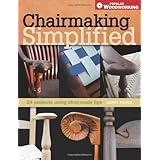
Average Reviews:

(More customer reviews)Are you looking to buy Chairmaking Simplified: 24 Projects Using Shop-Made Jigs (Popular Woodworking)? Here is the right place to find the great deals. we can offer discounts of up to 90% on Chairmaking Simplified: 24 Projects Using Shop-Made Jigs (Popular Woodworking). Check out the link below:
>> Click Here to See Compare Prices and Get the Best Offers
Chairmaking Simplified: 24 Projects Using Shop-Made Jigs (Popular Woodworking) ReviewI bought this book because I was interested in learning how to make shaker chairs, and wanted a thorough, comprehensive treatment of the details. This book comes very close to achieving all I had hoped for it, but it has a fatal flaw. First, let me explain the good points. The book does provide a comprehensive and thorough treatment of building shaker chairs from turning legs and rungs on the lathe through mortising the legs, shaping arms, rockers, and weaving the seat with shaker chair tape as well as rushes. The book is well organized and the author's approach seems quite appealing. The author does a terrific job of explaining nearly every phase of shaker chair building. Now for the fatal flaw. The author's approach relies completely upon two clever jigs: a front mortise rung jig (FMRJ) and a side mortise rung jig (SMRJ). The book provides (on page 67) drawings for the two jigs as well as some photographs of them on other pages. Unfortunately, the jigs cannot be built with the information provided in the drawings. In the SMRJ, for example, there is a trapezoidal shaped piece. The drawing provides the height of the longer leg of the trapezoid, but not the height of the shorter leg. Since the relative dimensions of these two legs determine the critical angle at which mortises are drilled, you really need this information to build the jig. This dimension cannot be determined by other information in the drawing nor can it be determined from information given in the text. Furthermore, the critical angle is discussed in general terms in the text, but nowhere specified (had it been, the dimension needed could have been worked out with elementary trigonometry).The situation with the FMRJ is not any better. One of the dimensions in the drawing is missing. Furthermore, the photographs of the jig in the book do NOT correspond to the drawing. Thus it is pretty well impossible to determine exactly how to build this jig. The only thing that alleviates this situation is that, in this case, the jig is used to drill mortises at a 90 degree angle. Thus, one can see exactly what is intended and, I believe it would be pretty straightforward to design a jig to accomplish the intended task.
One final caveat. The section on turning and sharpening may be a questionable inclusion. Other books dealing solely with turning (Darlow's books, for example) provide a much more comprehensive (and better) treatment of turning and sharpening. I suppose its inclusion can be justified on the basis of providing a complete reference under one cover.
Without the two jigs, however, the author's approach cannot be carried out. While some experimentation (involving wasted time, material, and money on the reader's part) may resolve the dimensioning problems with the jig drawings, it irks me to have to spend my time and money doing so when a competent editing job could have obviated the necessity of doing so.
The author came very close to having a true classic here (one which would have rated 5 stars easily, and was prevented from doing so only by a careless editor. My advice to the author: find a way to get an addendum to the book out on the web correcting these errors.
Chairmaking Simplified: 24 Projects Using Shop-Made Jigs (Popular Woodworking) Overview"Chairmaking Simplified" offers the complete chair experience for woodworkers by providing not only step-by-step instructions for an in-depth education on chairmaking but also a history of chair design and a section on how to design a comfortable chair.Other titles have covered very specific chairs such as Windsor or Shaker, but this is the first title to break the chairmaking process into simple steps with jigs that can be used to create a variety of chair styles and configurations (with many never before published). At least one favourite for every woodworker is guaranteed. Kerry's jigs simplify the process of chairmaking, and his voice offers clear, easy instruction.
Want to learn more information about Chairmaking Simplified: 24 Projects Using Shop-Made Jigs (Popular Woodworking)?
>> Click Here to See All Customer Reviews & Ratings Now
0 comments:
Post a Comment